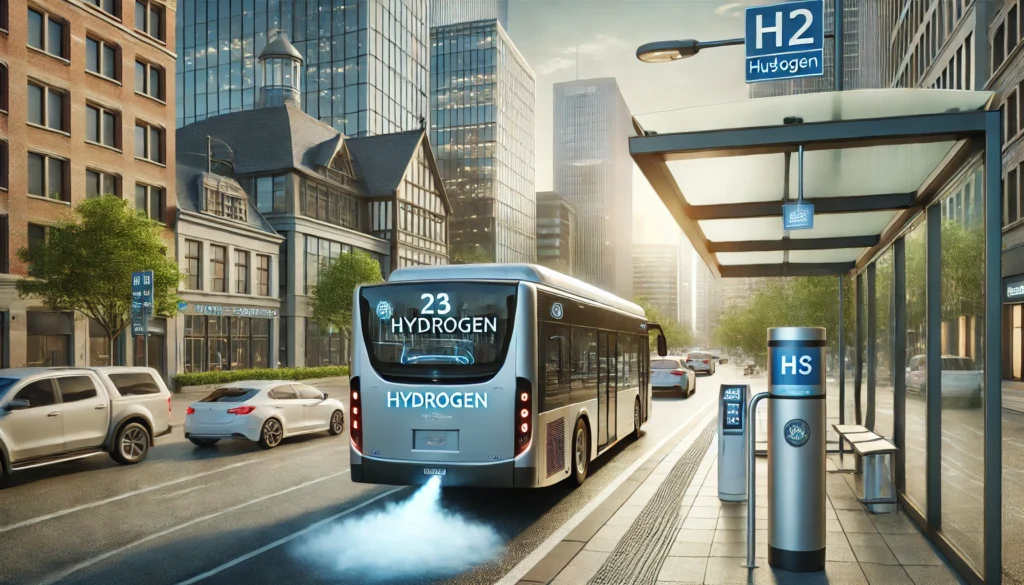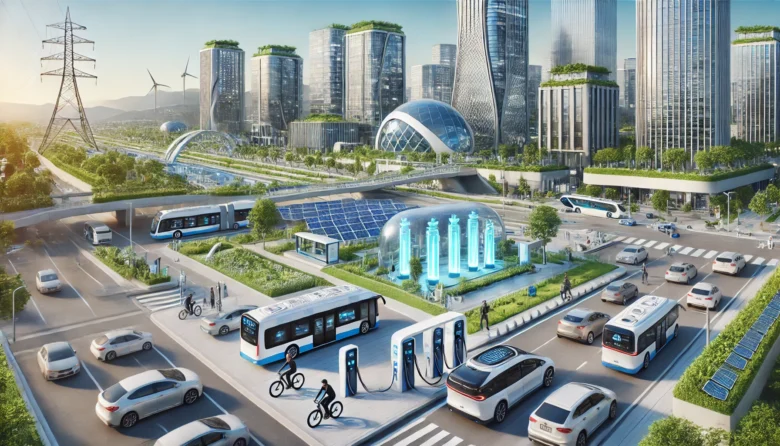Imagine a world where your car runs on one of the most abundant elements in the universe—hydrogen. This isn’t a sci-fi fantasy; it’s the promising reality of hydrogen fuel cells. As India seeks sustainable and eco-friendly energy solutions, hydrogen fuel cells are emerging as a key player. Let’s explore how this innovative technology works and its potential impact on India’s energy landscape.
What are Hydrogen Fuel Cells?
Hydrogen fuel cells generate electricity through a chemical reaction between hydrogen and oxygen. Unlike conventional engines that burn fuel, fuel cells produce electricity, heat, and water through an electrochemical process. This clean energy technology emits only water vapor, making it a green alternative to fossil fuels.
How Do Hydrogen Fuel Cells Work?
A hydrogen fuel cell consists of three main parts:
Anode: Hydrogen gas is fed into the anode, where it is split into electrons and protons.
Electrolyte: The protons pass through the electrolyte to the cathode, while the electrons create an electric current that can power a vehicle or other devices.
Cathode: Oxygen from the air combines with the protons and electrons at the cathode, producing water and heat as byproducts.

The Potential of Hydrogen Fuel Cells in India
India faces significant energy challenges, including a growing demand for electricity, air pollution, and dependence on imported oil. Hydrogen fuel cells offer a sustainable solution to these problems:
Clean Energy: Hydrogen fuel cells produce zero emissions, reducing air pollution and greenhouse gas emissions.
Energy Security: Hydrogen can be produced locally from various sources, including water, natural gas, and biomass, reducing reliance on imported fuels.
Versatility: Fuel cells can power a wide range of applications, from vehicles and homes to industrial processes and portable devices.
Advantages of Hydrogen Fuel Cells
Environmental Benefits: Hydrogen fuel cells emit only water vapor, significantly cutting down on harmful emissions.
Efficiency: Fuel cells are more efficient than internal combustion engines and can provide continuous power as long as fuel is supplied.
Energy Storage: Hydrogen can be stored and transported, making it a versatile energy carrier.
Scalability: Fuel cells can be used in various sizes and capacities, from small portable devices to large power plants.
Applications of Hydrogen Fuel Cells
Transportation:
-
- Cars and Buses: Companies like Toyota (known for its innovative hybrid and fuel cell vehicles) and Hyundai (a global leader in automotive technology) are developing hydrogen-powered cars and buses. Hydrogen fuel cell vehicles (FCVs) offer long driving ranges and quick refueling times.
- Trains and Ships: Hydrogen fuel cells are being explored for trains and ships, offering a clean alternative to diesel engines.
Stationary Power:
-
- Residential Power: Fuel cells can provide electricity and heat for homes, reducing reliance on the grid and lowering energy bills.
- Backup Power: Data centers, hospitals, and other critical facilities can use fuel cells as a reliable backup power source during outages.
Portable Power:
-
- Gadgets: Fuel cells can power laptops, smartphones, and other portable electronics, offering longer usage times compared to traditional batteries.
Challenges and Solutions
While hydrogen fuel cells hold great promise, there are challenges to overcome:
Infrastructure Development: Building a network of hydrogen refueling stations is essential for the widespread adoption of hydrogen-powered vehicles. Government support and public-private partnerships can accelerate infrastructure development.
Cost: The production, storage, and distribution of hydrogen can be expensive. Technological advancements and economies of scale are expected to reduce costs over time.
Production Methods: Currently, most hydrogen is produced from natural gas, which generates carbon emissions. Developing green hydrogen production methods, such as electrolysis using renewable energy, is crucial.
India’s Initiatives in Hydrogen Fuel Cells
India is making strides in hydrogen fuel cell technology:
National Hydrogen Mission: Launched by the Indian government, this mission aims to make India a global hub for hydrogen production and export. The focus is on green hydrogen, which is produced using renewable energy sources.
Research and Development: Institutions like the Indian Institute of Technology (IIT) Madras are conducting research to improve fuel cell efficiency and develop cost-effective production methods.
Industry Collaboration: Indian companies like Tata Motors (a leading automotive manufacturer) and Reliance Industries (a major conglomerate with interests in energy) are investing in hydrogen technology and infrastructure.
The Future Outlook
The future of hydrogen fuel cells in India looks promising. With ongoing research, supportive government policies, and increasing investments, hydrogen could play a significant role in India’s energy transition. As technology advances and costs decrease, hydrogen fuel cells will become more accessible and widely adopted.
Conclusion
Hydrogen fuel cells represent a powerful and sustainable solution to many of India’s energy challenges. By embracing this technology, India can reduce its carbon footprint, enhance energy security, and pave the way for a cleaner, greener future. The journey towards widespread adoption of hydrogen fuel cells is just beginning, and the possibilities are endless.
Author’s Note
Thank you for joining me on this exploration of hydrogen fuel cells and their potential impact on India. If you found this blog enlightening, please share it with others interested in sustainable energy solutions. Together, we can drive the change towards a more sustainable future.
G.C., Ecosociosphere contributor.
References and Further Reading:
- National Hydrogen Mission
- Indian Institute of Technology (IIT) Madras
- . https://www.makeitstraight.com/blogs/news/how-to-straighten-hair-without-heat
- Hydrogen Fuel Cells: The Next Big Thing in Energy? | Reach. https://www.discoverreach.com/news/hydrogen-fuel-cells-the-next-big-thing-in-energy
- Dash, S., Dash, S., Chakraborty, S., Roccotelli, M., Roccotelli, M., & Sahu, U. (2022). Hydrogen Fuel for Future Mobility: Challenges and Future Aspects. Sustainability, 14(14), 8285.
- Hassan, Q., Hassan, Q., & Salman, H. (2023). Hydrogen Fuel Cell Vehicles: Opportunities and Challenges. Sustainability, 15(15), 11501.
- How hydrogen fuel cells work: An in-depth look at the technology powering zero-emissions vehicles – ENGINEERING APPLICATIONS. https://www.hkdivedi.com/2023/04/how-hydrogen-fuel-cells-work-in-depth.html
- How To Build A Hydrogen Fuel Cell – Ecologic Power. https://ecologic-power.com/how-to-build-a-hydrogen-fuel-cell/
- Turan, C. (2011). Investigations on the Effect of Manufacturing on the Contact Resistance Behavior of Metallic Bipolar Plates for Polymer Electrolyte Membrane Fuel Cells. https://core.ac.uk/download/51289671.pdf
- Renewable Energy – Blue Valley. https://www.bv-investment.com/renewable-energy/
- How to Charge Your Phone Without Electricity: A Comprehensive Guide – Daily Tech Talk. https://dailytechtalk.com/how-to-charge-your-phone-without-electricity.html
- Bambara, J., & Athienitis, A. (2019). Energy and economic analysis for the design of greenhouses with semi-transparent photovoltaic cladding. Renewable Energy. https://doi.org/10.1016/j.renene.2018.08.020
- Shankar, A., & Bukya, M. (2022). Decentralization to decarbonize the Indian economy. https://doi.org/10.13135/2384-8677/7153
- . https://www.eai.in/blog/2024/02/green-hydrogen-powered-vehicles-rwe-and-westfalen-group-partner.html
- Ants Running in Circles: Unraveling the Mystery | PestWeek. https://pestweek.com/ants-running-in-circles/




